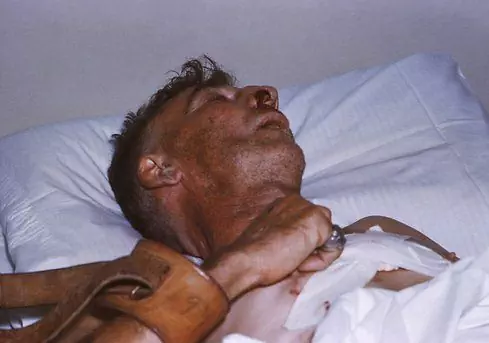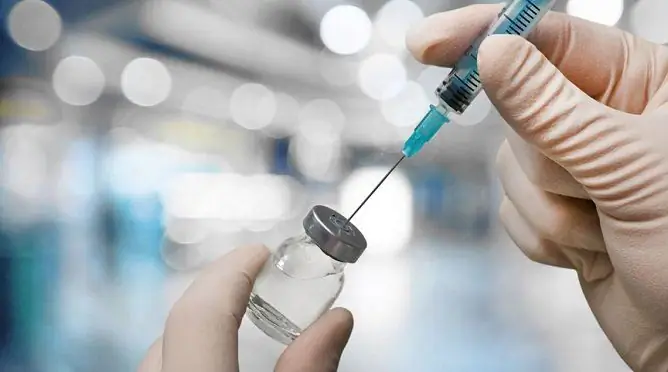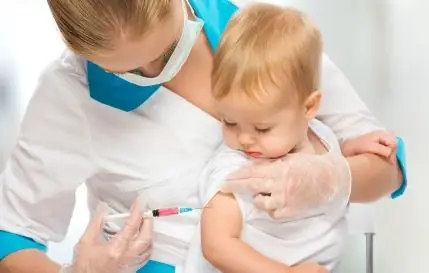- Author Rachel Wainwright [email protected].
- Public 2023-12-15 07:39.
- Last modified 2025-11-02 20:14.
Kokav
Kokav: instructions for use and reviews
- 1. Release form and composition
- 2. Pharmacological properties
- 3. Indications for use
- 4. Contraindications
- 5. Method of application and dosage
- 6. Side effects
- 7. Overdose
- 8. Special instructions
- 9. Application during pregnancy and lactation
- 10. Drug interactions
- 11. Analogs
- 12. Terms and conditions of storage
- 13. Terms of dispensing from pharmacies
- 14. Vaccine reviews
- 15. Price in pharmacies
Latin name: Cocav
ATX code: J07BG01
Active ingredient: Vaccine for the prevention of rabies (Vaccine rabies)
Producer: FSUE NPO Microgen Russia
Description and photo updated: 2018-26-07

Kokav is a vaccine used to prevent rabies.
Release form and composition
The drug is produced in the form of a lyophilisate for the preparation of a solution for intramuscular administration: a white hygroscopic porous mass (in ampoules, 5 ampoules in a cardboard box, complete with a solvent).
The composition of 1 dose includes:
- Active substance: inactivated rabies vaccine virus, Vnukovo-32 strain - not less than 2.5 IU (international units);
- Auxiliary components: sucrose - 75 mg, human albumin - 5 mg, gelatin - 10 mg.
Solvent: water for injection.
Pharmacological properties
Pharmacodynamics
The vaccine activates cellular and humoral immunity against the rabies virus. Kokav provides a protective level of specific antibodies, the maximum concentration of which is reached by 45 days after the start of the vaccine.
Pharmacokinetics
Data on the pharmacokinetic properties of the drug are not provided.
Indications for use
- Preventive immunization: for the immunization of persons at high risk of contracting rabies, including laboratory staff working with street rabies virus, foresters, veterinarians, hunters, gamekeepers, persons carrying out work on keeping and trapping animals, as well as other professional groups;
- Therapeutic and prophylactic immunization: in case of contact and bites of people by animals (unknown, wild, as well as with confirmed rabies or if it is suspected).
Contraindications
Prophylactic immunization is contraindicated in the presence of the following diseases / conditions:
- Chronic diseases (with exacerbation or decompensation), acute infectious and non-infectious diseases (the drug can be used no earlier than one month after remission (recovery));
- Systemic allergic reactions to previous use of Kokava, manifested in the form of a generalized rash, Quincke's edema, etc.;
- Pregnancy.
There are no contraindications for prophylactic immunization.
Instructions for use Kokava: method and dosage
Before use, the contents of the Kokava ampoule must be dissolved in 1 ml of water for injection. Dissolving time - no more than 5 minutes. The finished vaccine is a slightly opalescent or clear liquid from light yellow to colorless. Do not store dissolved Kokava vaccine for more than 5 minutes.
The drug should be injected intramuscularly slowly into the deltoid muscle of the shoulder, for children under 5 years old - into the upper part of the anterolateral surface of the thigh (it cannot be injected into the gluteal region).
Antirabies care is a local treatment of abrasions, wounds, salivation and scratches, followed by the introduction of Kokava for the prevention of rabies or, if indicated, the introduction of antirabies immunoglobulin (RIG) and Kokava at intervals of up to 30 minutes.
It is advisable to start local treatment of wounds (abrasions, scratches, bites) and salivation immediately or as soon as possible after injury or bite. The wound surface is washed abundantly for several minutes (up to 15 minutes) with soap and water or other detergent, or, in their absence, with a stream of water. After that, the edges of the wound should be treated with 5% alcohol solution of iodine or 70% ethyl alcohol.
Suturing wounds should be avoided whenever possible. Suturing is only indicated in the following situations:
- Extensive wounds: after preliminary treatment of the wound, several directing skin sutures are applied;
- Cosmetic indications (mainly in the face area);
- Bleeding vessels: to stop external bleeding.
If there are indications for the use of rabies immunoglobulin, it should be used immediately before suturing.
Treatment-and-prophylactic immunization begins immediately after local treatment of wounds (injuries). All persons who are at risk of contracting rabies are subject to it. If there are indications for combined treatment, AIH is administered first and then, with a break of up to 30 minutes, Kokav.
Before the introduction of equine (heterologous) AIH, it is necessary to check the patient's individual sensitivity to horse proteins. The drug should be administered within 3 days after the bite at a dose of 40 ME per 1 kg of body weight, but not more than 20 ml. It is not necessary to test the sensitivity before using human (homologous) AIH. The vaccine is administered at a dose of 20 IU per 1 kg of body weight.
As much of the recommended dose of AIH as possible should be infiltrated into and around the tissue. The unused portion of the dose is injected deep intramuscularly in a place other than the administration of the rabies vaccine.
In the absence of damage to the skin, salivation of the mucous membranes and skin of animals with rabies, treatment and prophylactic immunization is not carried out.
In case of salivation of intact skin, the presence of abrasions, scratches, superficial bites of the trunk, lower and upper extremities (except for the face, head, hands, neck, toes and hands), inflicted by domestic and farm animals, if within 10 days observations, the animal remains healthy, after the third injection, treatment is stopped. With laboratory evidence of the absence of rabies in the animal, from this moment the therapy is canceled. In all other cases, the introduction of Kokava is continued according to the following scheme: 1 ml at 0, 3, 7, 14, 30 and 90 days.
With any salivation of the mucous membranes, bites of the face, head, neck, genitals, hands and toes and fingers, as well as with single or multiple deep lacerations inflicted by agricultural or domestic animals, if the animal remains healthy for 10 days of observation, after the third injection, treatment is stopped. With laboratory evidence of the absence of rabies in the animal, from this moment the therapy is canceled. In all other cases, combination therapy is prescribed: AIH on day 0 and Kokav 1 ml at 0, 3, 7, 14, 30 and 90 days.
The course of therapeutic and prophylactic immunization should be prescribed regardless of the time the victim turns for help (even several months after contact with the animal). For adults and children, the doses and regimens of therapeutic and prophylactic immunization do not differ.
For persons who previously received a full course of preventive or therapeutic and prophylactic vaccinations, and no more than 1 year has passed since its completion, Kokav is prescribed for the prevention of rabies 1 ml at 0, 3 and 7 days; more than a year - they carry out a full treatment and prophylactic course.
After completing the course of immunization (prophylactic or treatment-prophylactic), the vaccinated person is issued a certificate (certificate of prophylactic vaccinations) indicating the series and type of drugs, the course of vaccinations and information about post-vaccination reactions.
During the entire course of vaccinations, hypothermia, overwork, overheating should be avoided. Also, during the entire course and six months after its completion, alcohol should not be consumed.
Immunosuppressants and glucocorticosteroids can lead to the ineffectiveness of vaccine therapy. Therefore, when carrying out vaccination while taking these drugs, it is mandatory to determine the titer of neutralizing antibodies. In the absence of neutralizing antibodies, an additional course of vaccine administration is carried out according to the scheme of 0, 7 and 30 days.
When carrying out prophylactic immunization, 1 ml of Kokava is injected intramuscularly into the deltoid muscle of the shoulder on days 0, 7 and 30, revaccination - 1 ml once a year and then every three years.
You should not use the Kokav rabies vaccine if the integrity, labeling of the ampoule is compromised, as well as if the transparency and color of the lyophilisate changes, if the product is not stored correctly or has expired. The opening of the ampoules and the vaccination procedure must be carried out with strict adherence to the rules of asepsis. After the procedure, the vaccinated must be under medical supervision for at least 30 minutes.
Side effects
According to the instructions, Kokav can cause the following side effects:
- Local reactions: an increase in regional lymph nodes, hyperemia, itching, redness, slight swelling, soreness at the injection site;
- General reactions: malaise, headache, weakness, fever, systemic allergic reactions in the form of Quincke's edema and generalized rash (symptomatic therapy and the use of hyposensitizing agents are recommended).
With the development of neurological symptoms, the patient needs to be urgently hospitalized.
After administration of AIH from horse blood serum, the following complications may develop:
- Local allergic reactions (usually occur 1-2 days after drug administration);
- Serum sickness (usually occurs 6-8 days after drug administration);
- Anaphylactic shock.
If anaphylactic reactions occur, it is necessary to carry out emergency care (administration of norepinephrine, epinephrine, ephedrine) and further observation in a specialized institution.
If signs of serum sickness occur, parenteral administration of glucocorticosteroids, calcium preparations and H 1 blockers - histamine receptors is recommended.
Overdose
There are currently no cases of overdose.
special instructions
During the period of therapy, patients are advised to avoid driving vehicles and performing other types of work that require a high concentration of attention and quick psychomotor reactions.
Application during pregnancy and lactation
The use of the Kokav rabies vaccine during pregnancy and breastfeeding is possible only for the purpose of prophylaxis or treatment for vital indications.
Drug interactions
Kokav preventive vaccination can be carried out no earlier than 1 month after vaccination against other infectious diseases.
During preventive vaccination, the use of other vaccines is prohibited (vaccination with other drugs can be carried out no earlier than after 2 months).
Prescribing drugs such as immunosuppressants and corticosteroids during preventive immunization is possible only for health reasons.
Analogs
There is no information about Kokava analogues.
Terms and conditions of storage
Keep out of reach of children at 2-8 ° C.
The shelf life is 1.5 years.
Terms of dispensing from pharmacies
Released only for medical institutions.
Reviews of the Kokav vaccine
Patients who received the Kokav vaccine note its effectiveness. According to reviews, Kokav not only protects against rabies, but prevents 100% death in the event of a bite from an infected animal.
The disadvantages of the vaccine are its toxicity and the risk of allergic reactions.
Price for Kokav in pharmacies
The vaccine is not sold in pharmacies and is intended for use only in healthcare facilities.
The price of Kokav is high - from 2500 rubles per pack containing 5 ampoules of lyophilisate complete with a solvent.

Anna Kozlova Medical journalist About the author
Education: Rostov State Medical University, specialty "General Medicine".
Information about the drug is generalized, provided for informational purposes only and does not replace the official instructions. Self-medication is hazardous to health!






